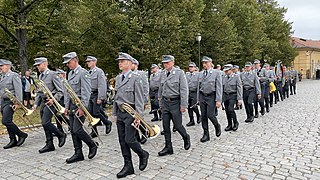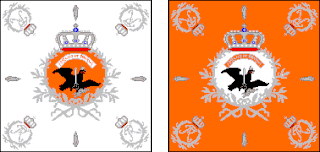
A fife is a small, high-pitched, transverse aerophone, that is similar to the piccolo. The fife originated in medieval Europe and is often used in fife and drum corps, military units, and marching bands. Someone who plays the fife is called a fifer. The word fife comes from the German Pfeife, meaning pipe, which comes from the Latin word pipare.

A fife and drum corps is a musical ensemble consisting of fifes and drums. In the United States of America, fife and drum corps specializing in colonial period impressions using fifes, rope tension snare drums and rope tension bass drums are known as Ancient Fife and Drum Corps. Many of these ensembles originated from a type of military field music.

In rudimental drumming, a form of percussion music, a drum rudiment is one of a number of relatively small patterns which form the foundation for more extended and complex drumming patterns. The term "drum rudiment" is most closely associated with various forms of field drumming, where the snare drum plays a prominent role. In this context "rudiment" means not only "basic", but also fundamental. This tradition of drumming originates in military drumming and it is a central component of martial music.
The Panzerkorps Großdeutschland was a German panzer corps in the Wehrmacht which saw action on the Eastern Front in 1944/1945 during World War II.

The Battle of Soor was a battle between Frederick the Great's Prussian army and an Austro-Saxon army led by Prince Charles Alexander of Lorraine during the Second Silesian War. The battle occurred in the vicinity of Soor, also known as Hajnice, in the modern day Czech Republic. The battle started with a failed Austrian surprise attack on the outnumbered Prussians. Despite initial setbacks the Prussian army managed to defeat the Austrians, due to an unexpected attack from a reserve regiment that refused to follow Frederick's orders.

The French Revolutionary Army was the French land force that fought the French Revolutionary Wars from 1792 to 1802. In the beginning, the French armies were characterised by their revolutionary fervour, their poor equipment and their great numbers. However, the French Revolutionary Army had become arguably the most powerful army in the world by the mid-1790s, as the French armies had become well-experienced and organized, enabling them to comfortably outfight their enemies.

The 23rd Armoured Brigade, originally formed as the 23rd Army Tank Brigade, was an armoured brigade of the British Army that saw service during the Second World War. The brigade was a 2nd Line Territorial Army (TA) formation. It was reorganised and renamed the 23rd Armoured Brigade, when it was assigned to the 8th Armoured Division, although it never operated under command of the division.

Martial music or military music is a specific genre of music intended for use in military settings performed by professional soldiers called field musicians. Much of the military music has been composed to announce military events as with bugle calls and fanfares, or accompany marching formations with drum cadences, or mark special occasions as by military bands. However, music has been employed in battle for centuries, sometimes to intimidate the enemy and other times to encourage combatants, or to assist in organization and timing of actions in warfare. Depending on the culture, a variety of percussion and musical instruments have been used, such as drums, fifes, bugles, trumpets or other horns, bagpipes, triangles, cymbals, as well as larger military bands or full orchestras. Although some martial music has been composed in written form, other music has been developed or taught by ear, such as bugle calls or drum cadences, relying on group memory to coordinate the sounds.
Musician (Mus) is a rank equivalent to Private held by members of the Royal Corps of Army Music of the British Army and the Royal Marines Band Service. The rank was also previously used in the United States Army and Confederate States Army.

A corps of drums, sometimes known as a fife and drum corps or simply field music, is a traditional European military music formation. Historically, a Corps of Drums' primary role was communication. Today, the primary role of a Corps of Drums is ceremonial, performing in parades and military ceremonies. Besides drums, this formation may contain a variety of instruments, including trumpets, bugles, and fifes.

117th Jäger Division was a German infantry division of World War II. The division was formed in April 1943 by the reorganization and redesignation of the 717th Infantry Division. The 717th Division had been formed in April 1941. It was transferred to Yugoslavia in May 1941, to conduct anti-Četnik and anti partisan and Internal security operations.

A drummer was responsible for the army drums for use on the battlefield. Drums were part of the battlefield for hundreds of years, being introduced by the Ottomans to Europe. Chinese armies, however, had used drums even before this. With the professionalization of armies, military music was developed as well. Drums were used for the men to march in step and were also an important part of the battlefield communications system, with various drum rudiments being used to signal different commands from officers to troops. By the second half of the 18th century, most Western armies had a standardized set of marches and signals to be played, often accompanied by fifers.

A drum major in the military is the individual leading a military band or a field unit. It is an appointment, not a military rank. Military drum majors utilize a ceremonial mace for giving commands while marching. Many drum majors, particularly American- or British-influenced ones, wear a sash that can carry embroidered badges of their home unit and battle honors; a pair of ceremonial drum sticks are often attached.

The 1st Brigade is currently the largest unit of the New Zealand Army, and contains most of the army's deployable units. The brigade was formed on 13 December 2011 by amalgamating the 2nd Land Force Group and 3rd Land Force Group. Its establishment formed part of the 'Army 2015' package of reforms.

Military drums or war drums are all kinds of drums and membranophones that have been used for martial music, including military communications, as well as drill, honors music, and military ceremonies.

The Northwestern Operational Command (SZOK) is a command of the Belarus Ground Forces. It is headquartered at Borisov and is commanded by Major General Alexander Volfovich. The command includes a mechanized brigade and a mixed artillery brigade. It was formed in 2001 from the 65th Army Corps.
The 140th Rifle Division was a Red Army rifle division that saw service during the Great Patriotic War. Originally formed during the prewar buildup of the Red Army, the 140th might be regarded as the unluckiest division in the Army, as it, uniquely, had to be completely, or almost completely, re-formed three times between 1941 and 1943, being destroyed in the Uman pocket during Operation Barbarossa, the Vyasma pocket during Operation Typhoon, and on the Caucasian steppes in the face of the German summer offensive of 1942. In spite of this, the fourth formation of the 140th went on to have a very distinguished record in combat, a testament to the resiliency of the Red Army in World War II.
The 396th Rifle Division was created in 1941 as an infantry division of the Red Army and was activated twice during the Great Patriotic War. The division followed a very similar combat path to that of the 398th Rifle Division in its 1st formation. It was first formed in August in the Transcaucasus Military District. In January 1942 it was moved to the Crimea where it joined first the 47th and then the 44th Armies in Crimean Front. On 8 May it came under attack by the German 11th Army as part of Operation Trappenjagd and by the end of the month it was destroyed in the Kerch peninsula, being officially disbanded on 14 June. In the buildup to the Soviet invasion of Manchuria a new 396th was formed in the Far Eastern Front in early 1945. The new division was one of only three formed in 1945 and served with the 2nd Red Banner Army, crossing the Amur River on 11 August and helping to reduce a Japanese fortified zone while also marching towards central Manchuria. Its rifle regiments were all decorated for their achievements and the division was disbanded before the end of the year.

The military bands of the United Kingdom are musical units that serve for protocol and ceremonial duties as part of the British Armed Forces. They have been the basis and inspiration for many military bands in the former British Empire and the larger Commonwealth of Nations as well as musical organizations in other countries. Military musical units with British influence include United States military bands, the Japan Ground Self-Defense Force Music Corps and the Military Band of Athens. British military bands are controlled by the military music departments of the three services that compose the armed forces. These include the Royal Marines Band Service, the Royal Corps of Army Music, and the Royal Air Force Music Services. British style brass bands and carnival bands were then and are currently inspired by the British Armed Forces and its brass bands, especially of the Army's regular and reserve formations, as they follow a similar format as it relates to brass and percussion instruments.

The 1st Prussian Infantry Regiment was a line infantry regiment of the Old Prussian Army which had initially formed part of the Prussian Life Guard, but later transferred to the line. After notably serving in the War of the Austrian Succession and Seven Years' War, the regiment was demolished following the Battle of Auerstadt. A small part of the regiment went on to help form the famed 8th Life Infantry Regiment, which in turn would serve notably till its disbandment after World War I.















